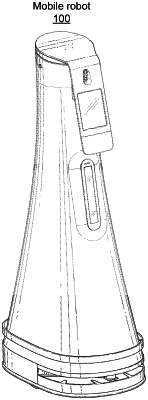| CPC H04N 7/185 (2013.01) [G01C 21/3453 (2013.01); G05D 1/0088 (2013.01); G05D 1/0219 (2013.01)] | 21 Claims |

|
1. A mobile robot, comprising:
a motorized base configured to move the mobile robot within a building;
a wireless transceiver configured to communicatively couple to a remote security system;
a camera system configured to capture images of the mobile robot's surroundings; and
a controller configured to:
identify a pre-determined individual in an image captured by the camera system;
configure the mobile robot to monitor the identified individual;
while the individual is being monitored by the mobile robot, determine that the individual triggers a security condition comprising moving within a threshold distance of a boundary defining an area to which the individual does not have access;
in response to the individual moving within the threshold distance of the boundary, cause the mobile robot to 1) project an indication of the boundary on the ground and 2) warn the individual not to cross the boundary and perform a security operation without human operator intervention; and
in response to determining that the individual has crossed the boundary, perform an enhanced security operation determined to be more likely than the performed security operation to eliminate the security condition.
|